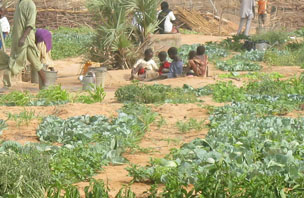Project Description
In the landscapes supported by the USAID Resilience ANCHORS Activity, the communities do not have adequate oversight and rights over natural resources, resulting in reduced capacity to generate long-lasting benefits. The lack of integrated water management also affects access to and provision of a healthy, safe, and sustainable water supply. Moreover, livelihood options are limited due to a lack of or reduced linkages to markets. Corruption, elite capture, and governance challenges further affect rural communities’ livelihoods when it comes to benefiting from wildlife and natural resources. All these issues lead to a lack of resiliency when it comes to shocks and stresses, like drought, human-wildlife conflict, and the negative effects of climate change. Resilience ANCHORS then aims to strengthen the resilience of communities around protected landscapes and associated wildlife corridors.
The USAID/Zimbabwe Resilience through Accelerating New Community-based Holistic Outcomes for Resource Sustainability (Resilience ANCHORS) Activity is a five-year project focused on building the capacity of local partners and communities on sustainable natural resources governance to safeguard biodiversity and build community resilience. The project empowers Zimbabwean communities in the Southeast Lowveld (SEL) and the Mid-Zambezi Valley (MZV) to develop selected landscapes into “resilience anchors” and reduce their vulnerability to climatic shocks and economic stresses. The Activity works closely with local organizations and partner with communities to manage natural resources in a way that creates economic growth, assures conservation of biodiversity and water resources, improves community livelihoods, and promotes resilience. It has three objectives: (1) Improve economic benefits from strengthened community-level governance and oversight of conservation enterprises; (2) Increase sustainable access to supplies of water of sufficient quantity and quality to meet human, economic, and ecosystem needs; and (3) Strengthen locally-led development and private sector engagement. Resilience ANCHORS works with a broad array of local partners, including communities, the private sector, civil society, and local government bodies to achieve these goals, drawing on its extensive experience in community and private sector engagement and natural resource governance.
USAID Resilience ANCHORS Activity supports Zimbabwean communities surrounding protected areas and wildlife corridors, to sustainably manage and draw economic benefits from their local natural resources. In the SEL, the Activity has increasingly focused on supporting the Savé Valley Conservancy, and the adjacent Nyangambe Community Conservancy and nascent Devure Community Conservancy and their associated communities. Outside of Gonarezhou National Park, the Activity supports the communities near the Jamanda Community Conservancy. Across the Mid-Zambezi Valley, Resilience ANCHORS implements across the districts of Hwange, Binga, and Nyaminyami, with a range of communities near protected wilderness areas, such as Hwange and Matusadona national parks.
Interventions have increased the communities’ ability to sustainably protect and manage community-based natural resources and the wildlife economy in anticipation of future shocks and stresses. In addition, several households have improved access to water, benefiting their livestock and increasing economic benefits and diversified livelihoods. Private-sector engagement efforts have connected households to various agricultural and non-timber forest product value chain opportunities, further enhancing livelihood options for vulnerable communities sharing boundaries with wildlife areas.
To learn more about the activity, watch this video detailing how chili production in Chipinge is helping female farmers grow local economies and contribute to household resilience.
 Project Objectives
Project Objectives
- To improve economic benefits from strengthened community-level resource governance and oversight of conservation enterprises
- To increase sustainable supplies of water of sufficient quantity and quality to meet human, economic, and ecosystem needs
- To strengthen locally-led development and private-sector engagement
USAID Resilience ANCHORS strategy is driven by interventions that include:
- Biodiversity Conservation
- Community Conservancies
- Community Environmental Governance and Natural Resource Management
- Human-Wildlife Conflict Mitigation
- Ecotourism
- Livelihood Diversification and Strengthening (through Conservation Enterprises)
- Non-Timber Forest Product Value Chains
- Integrated Land Use Planning
- Local Integrated Water Resource Management
- Climate-Smart Agriculture
- Community-Private Sector Partnerships





